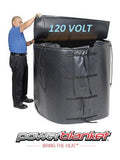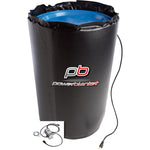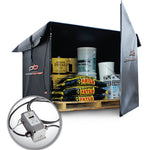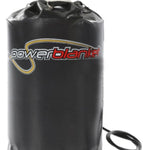You have no items in your shopping cart.
How to Store Water for Cold Weather Using a Tank
Article At-a-Glance
How Can You Effectively Store Water in Cold Weather?
To effectively store water in cold weather and prevent freezing, use insulated heating blankets or heaters designed for tanks and totes, ensuring they maintain temperatures above 32°F, and consider additional measures like moving tanks indoors or using battery-powered heating solutions.
Key Takeaways
- Understand Cold Water Storage Systems: Learn about different systems like chilled water tanks, ice storage, and cisterns, and how they function to maintain water at lower temperatures.
- Explore Applications and Uses: Discover the diverse applications of cold water storage, from agricultural irrigation and livestock use to domestic and industrial systems.
- Design and Best Practices: Gain insights into design guidelines, including sizing, configuration, and setup considerations to ensure efficient and safe water storage.
- Address Safety and Maintenance: Learn about safety measures to prevent bacterial growth, such as legionella, and other hazards associated with storing water at lower temperatures.
- Manage Cold Climate Challenges: Get practical tips for managing water storage in cold climates, including preventing freezing and maintaining desired temperatures with insulated heating solutions.
Figuring out how to store water during cold weather can be tricky. However, the answer will always be to use heat. Read on to find out the best way to store water during cold weather using a tank.

$1,948.99 USD
275 Gallon IBC Tote Heater w/ Lid Cover (120V)
For effective and efficient water storage during the cold season, consider Heat Authority tote warmers and heaters that keep your temperature-sensitive materials at the correct temperature.
How do you keep water storage tanks from freezing?
Water is a natural resource that is needed every single day of the year. From industrial uses to mountain getaway cabins, keeping water useable in its liquid state can be a challenge during the winter season.
Reasons you may need to store water in a tank or tote
Construction or other industries may need to store water in tanks or totes for a variety of reasons, including the following:
- To use as a source of drinking water
- To use in fire suppression systems
- To use as coolant in machinery or engines
- To clean equipment and tools
Caption: Water stored in tanks and troughs are vulnerable to freezing over in cold weather, leaving no water for animals to drink.
Whatever your reason for storing water in outdoor tanks, there is only one solution to prevent it from turning into a solid block of ice: heat.
The benefits of having a water storage tank or tote
Cold weather water storage tanks and totes provide on-site, immediate access to water when you need it. Easy portable, tanks and totes can be moved to different locations and even stacked for better storage.
Water tanks are usually made of plastic or metal material. Totes tend to be plastic with a metal cage-like wrapping around the exterior, providing structural support and helping prevent dents that might result from equipment banging into the tote. This is especially important if the tote is to be transported by truck or rail.
While totes and tanks have some differences in design, they each have one thing in common: both tanks and totes have poor insulative qualities. Neither of them hold in heat or keep the cold out.

Will water tanks freeze?
Yes, and it’s one of the worst things that can happen to your tank. It’s common knowledge that when water freezes and turns into ice, it expands, taking up more space than it did in its liquid state. Containers like tanks, totes, or even pipes can crack under this pressure made by ice formation. Preventing ice formation is critical to ensure you have a usable supply of water in your storage tanks.
How to winterize your water storage tank
If you live in a cold climate, it is important to winterize your water tank or tote. This will protect the water from freezing and causing damage, saving you time and money by preventing costly repairs.
To winterize a tank or tote, follow these steps:
- Shut off the water supply to the tank or tote
- Drain the water from the tank or tote
- Disconnect the hoses from the tank or tote
- Cover the tank or tote with a tarp or blanket
- Place a heater near the tank or tote (if available)
Tips for using your stored water during a power outage
Water will begin to freeze once temperatures dip below 32°F. While power is required to provide the necessary heat needed to keep your water tanks and totes warm, there are other ways to help prevent water from freezing to keep it usable even when the power is out.
Water needs to stay above freezing for use, of course, so moving storage tanks to an indoor location can help ensure they don’t freeze as fast. That’s not always possible due to factors like tank and tote sizes.
Another option, though not an ideal one, is to regularly access the water inside of your tank or tote and stir the water inside. Moving the water breaks up any initial ice buildup. Depending on how cold the temperature is, you might notice some slush inside the tank as you return again and again to stir. While not a guaranteed tactic, stirring your water regularly can help mitigate the potential for freezing.
Heated insulation blankets keep cold out and trap heat in. If no power is available, insulation blankets can at least help slow the reach of cold inside of the tank or tote. Some even have internal heating elements that can be powered by batteries or other methods like solar panels to provide heat until the power comes back on. Various uses for heated construction blankets include using them to keep storage tanks warm, so if you have a spare one lying around, check to see if it can be used on your tote or tank.

Which type of tank or tote heater is best for you
Deciding what kind of water storage tote and tank heater you need is critical to making sure you can best store your water during all times of the year, including the cold weather season.
Tank or Tote capacity and dimensions
Once you’ve selected a water storage tank to use during the winter, make sure to remember its storage capacity and tank dimensions when purchasing additional equipment such as insulation blankets and tote heaters. Tote and tank heaters are built to keep water storage tanks and totes warm. Look for tote heaters and storage tank heaters that are designed to fit snugly around your tanks and totes. Check for any incoming or outgoing pipelines, valves, or hoses that might also need to be heated so water doesn’t freeze around these openings. If needed, use a valve heater and other tote and tank heating essentials to protect these vulnerabilities.
Tank heaters and tote heaters from Heat Authority
Heat Authority tote warmers and tank heaters efficiently and safely prevent ice formation inside your water storage, offering consistent, regulated heat distribution at a fraction of the cost of other industrial heating blanket alternatives. Our advanced insulation prevents heat loss and will protect down to -40°F/-40°C. The heating element within the blanket allows for more surface area contact, conserving energy and greatly reducing hot and cold spots.













